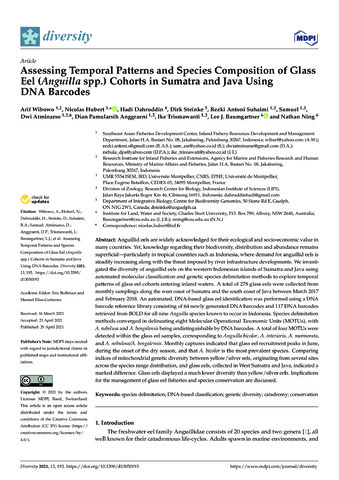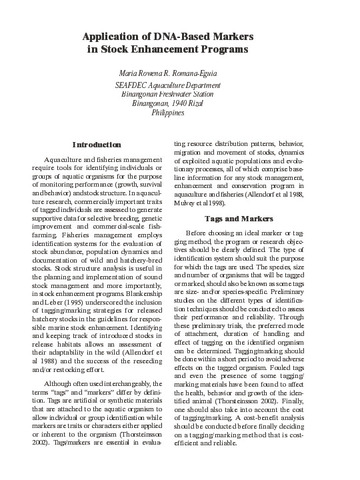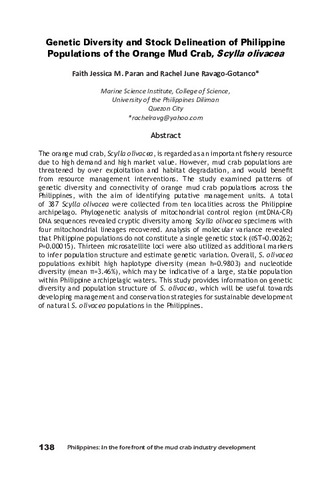Disentangling the taxonomy of the subfamily Rasborinae (Cypriniformes, Danionidae) in Sundaland using DNA barcodes
Share
| dc.contributor.author | Sholihah, Arni | |
| dc.contributor.author | Delrieu-Trottin, Erwan | |
| dc.contributor.author | Sukmono, Tedjo | |
| dc.contributor.author | Dahruddin, Hadi | |
| dc.contributor.author | Risdawati, Renny | |
| dc.contributor.author | Elvyra, Roza | |
| dc.contributor.author | Wibowo, Arif | |
| dc.contributor.author | Kustiati, Kustiati | |
| dc.contributor.author | Busson, Frederic | |
| dc.contributor.author | Sauri, Sopian | |
| dc.contributor.author | Nurhaman, Ujang | |
| dc.contributor.author | Dounias, Edmond | |
| dc.contributor.author | Zein, Muhamad Syamsul Arifin | |
| dc.contributor.author | Fitriana, Yuli | |
| dc.contributor.author | Utama, Ilham Vemandra | |
| dc.contributor.author | Muchlisin, Zainal Abidin | |
| dc.contributor.author | Agnese, Jean-Francois | |
| dc.contributor.author | Hanner, Robert | |
| dc.contributor.author | Wowor, Daisy | |
| dc.contributor.author | Steinke, Dirk | |
| dc.contributor.author | Keith, Philippe | |
| dc.contributor.author | Ruber, Lukas | |
| dc.contributor.author | Hubert, Nicolas | |
| dc.coverage.spatial | Indonesia | en |
| dc.date.accessioned | 2023-10-12T06:24:37Z | |
| dc.date.available | 2023-10-12T06:24:37Z | |
| dc.date.issued | 2020 | |
| dc.identifier.issn | 2045-2322 | |
| dc.identifier.uri | http://hdl.handle.net/20.500.14277/114 | |
| dc.description.abstract | Sundaland constitutes one of the largest and most threatened biodiversity hotspots; however, our understanding of its biodiversity is afflicted by knowledge gaps in taxonomy and distribution patterns. The subfamily Rasborinae is the most diversified group of freshwater fishes in Sundaland. Uncertainties in their taxonomy and systematics have constrained its use as a model in evolutionary studies. Here, we established a DNA barcode reference library of the Rasborinae in Sundaland to examine species boundaries and range distributions through DNA-based species delimitation methods. A checklist of the Rasborinae of Sundaland was compiled based on online catalogs and used to estimate the taxonomic coverage of the present study. We generated a total of 991 DNA barcodes from 189 sampling sites in Sundaland. Together with 106 previously published sequences, we subsequently assembled a reference library of 1097 sequences that covers 65 taxa, including 61 of the 79 known Rasborinae species of Sundaland. Our library indicates that Rasborinae species are defined by distinct molecular lineages that are captured by species delimitation methods. A large overlap between intraspecific and interspecific genetic distance is observed that can be explained by the large amounts of cryptic diversity as evidenced by the 166 Operational Taxonomic Units detected. Implications for the evolutionary dynamics of species diversification are discussed. | en |
| dc.description.sponsorship | Te authors wish to thank Siti Nuramaliati Prijono, Bambang Sunarko, Witjaksono, Mohammad Irham, Marlina Adriyani, Ruliyana Susanti, Rosichon Ubaidillah, the late Renny K. Hadiaty, Hari Sutrisno and Cahyo Rahmadi at Research Centre for Biology (RCB-LIPI) in Indonesia; Edmond Dounias, Jean-Paul Toutain, Robert Arf and Valérie Verdier from the ‘Institut de Recherche pour le Développement’; Joel Le Bail and Nicolas Gascoin at the French embassy in Jakarta for their continuous support. We also would like to thank Eleanor Adamson, Hendry Budianto, Tob Chann Aun, Pak Epang, Herman Ganatpathy, Sébastien Lavoué, Michael Lo, Hendry Michael, Joshua Siow, Heok Hui Tan, Elango Velautham, Norsham S. Yaakob, and Denis Yong for their help in the feld. We are also particularly thankful to Sumanta at IRD Jakarta for his help during the feld sampling in Indonesia. Part of the present study was funded by the Institut de Recherche pour le Développement (UMR226 ISE-M and IRD through incentive funds) to N.H.), the MNHN (UMR BOREA) to P.K., the French Ichthyological Society (SFI) to P.K., the Foundation de France to P.K., the French embassy in Jakarta to N.H., the Natural Environmental Research Council (NERC, NE/F003749/1) to L.R. and Ralf Britz; National Geographic (8509-08) to L.R. and North of England Zoological Society‐Chester Zoo to L.R. Te present study and all associated methods were carried out in accordance with relevant guidelines and regulation of the Indonesian Ministry of Research and Technology (Indonesia), the Economic Planning Unit, Prime Minister’s Department (Malaysia), the Forest Department Sarawak (Malaysia), the Vietnam National Museum of Nature (Vietnam) and the Inland Fisheries Research and Development Institute (Cambodia). Field sampling in Indonesia was conducted according to the research permits 097/SIP/FRP/SM/IV/2014 for Philippe Keith, 60/EXT/SIP/FRP/SM/XI/2014 for Frédéric Busson, 41/EXT/SIP/FRP/SM/VIII/2014 for Nicolas Hubert, 200/E5/E5.4/SIP/2019 for Erwan Delrieu-Trottin and, 1/TKPIPA/FRP/ SM/I/2011 and 3/TKPIPA/FRP/SM/III/2012 for Lukas Rüber. Te Fieldwork in Peninsular Malaysia and Sarawak was conducted under permits issued by the Economic Planning Unit, Prime Minister’s Department, Malaysia (UPE 40/200/19/2417 and UPE 40/200/19/2534) and the Forest Department Sarawak (NCCD.970.4.4[V]-43) and were obtained with the help of Norsham S. Yaakob (Forest Research Institute Malaysia, Kepong, Kuala Lumpur, Malaysia). Luong Van Hao and Pham Van Luc (Vietnam National Museum of Nature) helped with arranging research permits in Vietnam and So Nam (Inland Fisheries Research and Development Institute, IFReDI) helped with arranging research permits in Cambodia. All experimental protocols were approved by the Indonesian Ministry of Research and Technology (Indonesia), the Indonesian Institute of Sciences (Indonesia), the Forest Department Sarawak (Malaysia), Economic Planning Unit of the Prime Minister’s Department (Malaysia), the Vietnam National Museum of Nature (Vietnam) and the Inland Fisheries Research and Development Institute (Cambodia). It is a great pleasure to thank Soraya Villalba for generating the DNA barcodes at the Naturhistorisches Museum Bern. Sequence analysis was aided by funding through the Canada First Research Excellence Fund as part of the University of Guelph Food from Tought program. We thank Paul Hebert, Alex Borisenko and Evgeny Zakharov as well as BOLD and CCDB staf at the Centre for Biodiversity Genomics, University of Guelph for their valuable support. Tis publication has the ISEM number 2019-293-SUD. | en |
| dc.language.iso | en | en |
| dc.publisher | Nature Research | en |
| dc.relation.uri | https://www.nature.com/articles/s41598-020-59544-9.pdf | en |
| dc.rights | Attribution 4.0 International | * |
| dc.rights.uri | http://creativecommons.org/licenses/by/4.0/ | * |
| dc.subject | DNA barcoding | en |
| dc.subject | Cypriniformes | en |
| dc.subject | Cyprinoidei | en |
| dc.subject | species delimitation | en |
| dc.title | Disentangling the taxonomy of the subfamily Rasborinae (Cypriniformes, Danionidae) in Sundaland using DNA barcodes | en |
| dc.type | Article | en |
| dc.citation.volume | 10 | en |
| dc.citation.issue | 1 | en |
| dc.citation.spage | 2818 | en |
| dc.citation.journalTitle | Scientific Reports | en |
| dc.subject.asfa | biodiversity | en |
| dc.subject.asfa | DNA | en |
| dc.subject.asfa | taxonomy | en |
| dc.subject.asfa | DNA barcoding | en |
| dc.subject.asfa | freshwater fishes | en |
| dc.subject.asfa | species diversity | en |
| dc.subject.asfa | morphology | en |
| dc.subject.asfa | genomics | en |
| dc.subject.asfa | geographical distribution | en |
| dc.subject.asfa | genetic distance | en |
| dc.identifier.doi | 10.1038/s41598-020-59544-9 | |
| dc.subject.scientificName | Amblypharyngodon | en |
| dc.subject.scientificName | Boraras | en |
| dc.subject.scientificName | Trigonostigma | en |
| dc.subject.scientificName | Brevibora | en |
| dc.subject.scientificName | Pectenocypris | en |
| dc.subject.scientificName | Boraras maculatus | en |
| dc.subject.scientificName | Brevibora cheeya | en |
| dc.subject.scientificName | Kottelatia brittani | en |
| dc.subject.scientificName | Rasbora argyrotaenia | en |
| local.subject | Rasborinae | en |
Files in this item
| Files | Size | Format | View |
|---|
This item appears in the following Collection(s)
-
IFRDMD Journal Articles [10]
These papers were contributed by IFRDMD staff to various national and international journals




